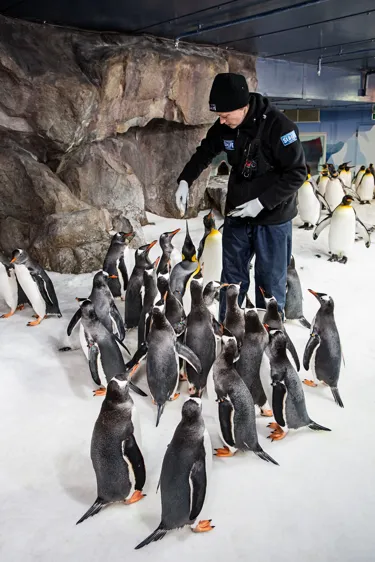Meet our Penguin Keeper - Laura
- Monday 14th September 2020

Penguin Keepers at SEA LIFE Kelly Tarlton’s Aquarium
In this series we'll be chatting with our resident penguin keepers to learn more about their role here at SEA LIFE Kelly Tarlton’s Aquarium, and what got them interested in choosing this career path. Read on to learn more about the staff who ensure the health and wellbeing of our resident King and Gentoo penguins and get some insights into the people behind the uniform. Because unlike our resident penguins, it’s not always black and white.
Q: How did you get this awesome job?
A: I was lucky enough to hear about a new position that was opening within the Penguin Department at Kelly Tarlton’s from a friend who was a part-time penguin keeper. It was 2004 and I’d just graduated with a Bachelor of Science majoring in Biology and Marine Science. I’d volunteered at the local vet clinic and worked in various pet shops throughout my five years at college, so didn’t anticipate that I would have skills applicable to caring for penguins. I was fortunate enough to get the penguin keeper role and then after a break to travel overseas I progressed to the Team Leader role in 2008, initially in a fixed term maternity cover capacity and then permanently.

Q: What do I look for when I hire a Penguin Keeper?
A: When I’m looking for a new Penguin Keeper to join our team, I look for someone who clearly has a real passion for animals. Obviously it’s quite difficult to get experience working with penguins, but if becoming a penguin keeper is something you’re interested in I’d recommend seeking any sort of experience in which you’re learning how to care for animals. So you don’t necessarily need a degree! Although indoors, we work in a challenging environment. Because we’re caring for sub-Antarctic penguins, their exhibit runs at 0°C, is covered by an ice base and is dark until 9am during winter. The work is strenuous - scrubbing, shovelling and raking ice! So I look for someone who can show commitment, loyalty and a strong work ethic. Of course, being able to work as part of a team is really important too.
Q: How do you remember all the penguin's names?
A: I remember when I first started at Kelly Tarlton’s I didn’t believe the team when they said they could tell them all apart. I thought there was no way, they’re all too similar!?! But once you get to know them the birds are all so different. The way that they walk, the size of their feet, their beaks, slight differences in feather markings and colours, the way they call, where they like to spend their time on the landmass, how they take a fish, who their friends are… the list goes on… Failing that, you can always take a look that their individual flipper bands!
Q: What's your best memory or experience working at SEA LIFE Kelly Tarlton's?
A: During our 2014 Gentoo penguin breeding season, one of our adult pairs had some real trouble caring for their chick. Little Cardi was underfed and weighed only 162g at 15 days of age, instead of the 400 – 500g she should have been. Because she needed medication every 8 hours, the decision was made to take her home to be cared for and hand-raised from that point. Each afternoon I would pack a fish bin full of things for the night – meds, fish slurry, towels, and blanket. For the first week, because she was so little I had to keep her warm with a heat pad throughout the night. Cardi started to grow rapidly once she was receiving lots of fish slurry and then I soon had to worry about keeping her cold enough! Within a week she went from needing a heat pack to then needing ice packs! Each day at work she would spend time with the other chicks which helped with her social development. It was such hard work looking after a little chick 24 hours a day for a month, but so rewarding to see her grow up to be a happy, social member of the colony.
Get to know our other penguin trainers
Get Closer to our Colony of Penguins
Experience an on-the-ice encounter like no other, as you venture into the world's largest sub-Antarctic penguin colony display with Penguin Passport!